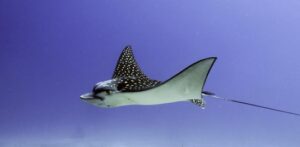
Spotted Eagleray
The spotted eagle ray, scientific name Aetobatus narinari, is a magnificent and graceful marine ray found in tropical and warm temperate waters around the world. Here are some interesting facts about the spotted eagle ray:
Appearance: Spotted eagle rays have a distinct and striking appearance. They have a diamond-shaped body with a long, slender tail that lacks a stinging spine. Their body is covered in a dark bluish-black or grayish-brown dorsal surface with numerous white spots or rings, giving them their name “spotted” eagle ray. The ventral side is usually white.
Size: Spotted eagle rays are one of the largest species of eagle rays. They can grow up to a wingspan of around 5 to 10 feet (1.5 to 3 meters) and can weigh over 500 pounds (230 kilograms). Females are generally larger than males.
Habitat: These rays inhabit a variety of marine environments, including coral reefs, seagrass beds, sandy or muddy bottoms, and shallow coastal areas. They are often found in clear, warm waters and are known to make seasonal migrations.
Feeding Habits: Spotted eagle rays are bottom-dwelling, cartilaginous fish with a diet that consists mainly of benthic invertebrates, such as mollusks, crustaceans, and small fishes. They use their flat, toothless mouths to crush and eat their prey, which they find by using their electroreceptive senses to detect the electrical fields emitted by buried or hidden prey.
Behavior: Spotted eagle rays are typically solitary, but they can also be seen in small groups or pairs. They are known for their acrobatic and elegant swimming, often seen gracefully gliding through the water with their wing-like pectoral fins. They have the ability to leap out of the water, possibly as a means of communication or to escape predators.
Reproduction: Spotted eagle rays are ovoviviparous, meaning their embryos develop inside eggs that hatch within the female’s body. The female gives birth to live young, usually one to four pups per litter, after a gestation period of around 10 to 12 months. The newborn pups are miniature versions of the adults and are self-sufficient upon birth.
Conservation Status: The conservation status of spotted eagle rays is currently listed as “Near Threatened” by the International Union for Conservation of Nature (IUCN). They face threats such as habitat loss, overfishing, entanglement in fishing gear, and pollution. Their low reproductive rate and slow growth make them vulnerable to population declines.
Ecological Role: Spotted eagle rays play an important ecological role as predators in their ecosystems. By feeding on benthic invertebrates, they help maintain the balance of populations within the marine food web. They also stir up the substrate while foraging, aiding in nutrient cycling and sediment health.
Interaction with Humans: Spotted eagle rays are often encountered by divers and snorkelers, as they are not generally aggressive towards humans unless provoked. However, caution should be exercised around their long tails, as they can be used defensively if threatened.
Research and Education: Scientific research on spotted eagle rays is ongoing to better understand their behavior, population dynamics, and conservation needs. Conservation efforts focus on habitat protection, sustainable fishing practices, and public education to raise awareness about the importance of protecting these majestic creatures.